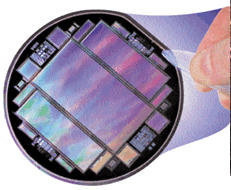 |
 he
new astronomical CCD is truly a spin-off of our high -energy physics detector
work," says the Engineering Division's Steve Holland, " and
had its origin in the R&D effort for the Superconducting Supercollider."
Most CCDs are semi-conductor devices that convert patterns of light intropatterns
of electric charge, which can be recorded and computer-processed to form he
new astronomical CCD is truly a spin-off of our high -energy physics detector
work," says the Engineering Division's Steve Holland, " and
had its origin in the R&D effort for the Superconducting Supercollider."
Most CCDs are semi-conductor devices that convert patterns of light intropatterns
of electric charge, which can be recorded and computer-processed to form
 images.
In particle-accelerator detectors, however, CCDs are used to pinpoint
hits by energetic particles. In contrast to astronomical CCDs, most of
them thinner than a human hair, a typical particle detector is a slab
of silicon 300 micrometers thick, about the thickness of a postcard. images.
In particle-accelerator detectors, however, CCDs are used to pinpoint
hits by energetic particles. In contrast to astronomical CCDs, most of
them thinner than a human hair, a typical particle detector is a slab
of silicon 300 micrometers thick, about the thickness of a postcard.
|
 |

